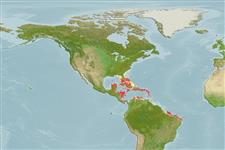Bivalvia |
Cardiida |
Tellinidae
Environment: milieu / climate zone / djupintervall / distribution range
Ekologi
; djupintervall 0 - 30 m (Ref. 83435). Tropical; 35°N - 9°S, 91°W - 61°E
Western Atlantic.
Length at first maturity / Size / Weight / Age
Könsmognad: Lm ? range ? - ? cm Max length : 8.8 cm NG hane/ej könsbestämd; (Ref. 83435)
Maximum depth from Ref. 104365.
Life cycle and mating behavior
Könsmognad | Reproduktion | Lek | Eggs | Fecundity | Larvae
Members of the class Bivalvia are mostly gonochoric, some are protandric hermaphrodites. Life cycle: Embryos develop into free-swimming trocophore larvae, succeeded by the bivalve veliger, resembling a miniature clam.
Bieler, R. and P.M. Mikkelsen 2004 Marine bivalves of the Florida Keys: A qualitative faunal analysis based on original collections, museum holdings and literature data. Malacologia 46(2):503-544. (Ref. 8163)
IUCN Red List Status
(Ref. 130435: Version 2025-1)
CITES status (Ref. 108899)
Not Evaluated
Not Evaluated
Threat to humans
Human uses
| FishSource |
Verktyg
Ytterligare information
Trophic EcologyFood items (preys)FödosammansättningFödointagPredatorer Population dynamicsTillväxt
Max. ages / sizes
Length-weight rel.
Length-length rel.
Length-frequencies
Mass conversion
Abundans
PhysiologySyreförbrukning
Human RelatedStamps, coins, misc.
Internet-källor
Estimates based on models
Preferred temperature
(Ref.
115969): 26.6 - 28.2, mean 27.5 (based on 346 cells).
Fishing Vulnerability
Low vulnerability (10 of 100).
